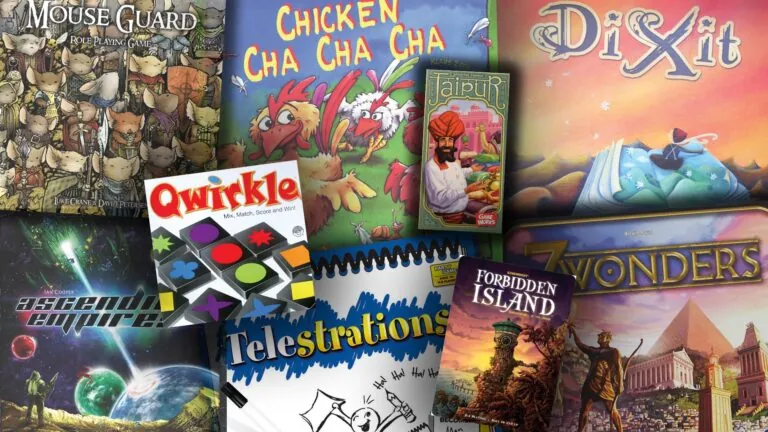Visitors to my house are often surprised at the number of board games I own. OK, I’ll be the first to admit that I probably have too many games. What’s nice about a game collection, though, is having games for different situations. Besides the obvious variation in the number of players and available playing time, different groups like different types of games. I’m not going to play the same game with my kids as I will with adults. Even adults vary in how much rules complexity and strategic depth they will tolerate in their games. Here are some suggestions for some games to fill those niches in a game collection. Most of these are pretty recent releases.
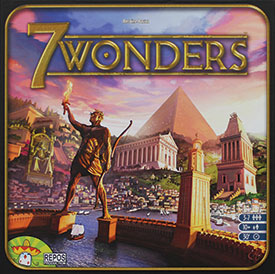 7 Wonders
7 Wonders
A quick game with strategic depth
This game hit my gaming group’s table for the first time in 2011 and it was a huge hit with all of us. In this card game, each player takes on a particular civilization, with a wonder to build. The game progresses through three ages. In each age, each player has a hand of cards and in your turn you choose one card to play. You can either play that card face up, playing any resource cost to bring the card into play, turn the card face down to build a stage of your wonder, or discard the card for money.
What makes the game interesting is that once you’ve done that, you pass your hand of cards to your neighbor and that player chooses a card from the hand you had. This creates some difficult decisions: do I build the card I want to build or do I discard a card to prevent it from going to my neighbor? At the end of the game, players score points for buildings they’ve built, how far they’ve progressed their wonder, the size of their military relative to your neighbors, coins they’ve earned and how far they have developed their science. There are multiple paths to victory and exploring these is part of the fun of the game.
What makes 7 Wonders so great is that it’s easy to learn and quick to play. Once you’ve got the rules down, a game of 7 Wonders can be completed in about a half hour, making it a great way to start or close out an evening of game playing, although you’ll probably find that you want to play several games in a row. It also scales very well, accommodating anywhere from two to seven players. Because all of the action is simultaneous, adding more players doesn’t add to the down time.
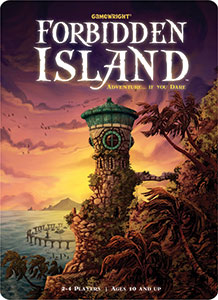 Forbidden Island
Forbidden Island
A game when you’re in a cooperative mood
Co-operative games are a nice change of pace in that players work together instead of against each other. Matt Leacock’s Forbidden Island takes the co-operative system he developed in Pandemic and distills it to its essence in a game that’s simpler and faster and more suitable for playing with kids. In Forbidden Island, players are stranded on an island made up of tiles. Slowly, tiles get flooded, making parts of the island inaccessible. Players are racing against time to acquire four treasures before the island disappears into the sea. Each player has a particular skill that allows him or her to break a particular game rule. Succeeding at the game requires players to work together and utilize their particular skills as effectively as possible.
What’s terrific about Forbidden Island is the wonderful sense of urgency and tension created by the game. Success and failure are balanced on a knife’s edge. In games where we’ve successfully escaped with the treasures, we just made it; games we lost could have been won with a different card draw. Either way, it’s exhilarating and fun. The game is relatively inexpensive, accommodates up to four players and takes 30 minutes to play.
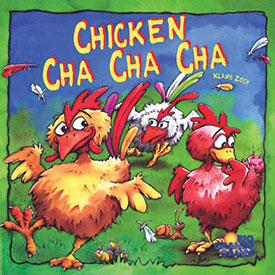 Chicken Cha Cha Cha
Chicken Cha Cha Cha
A game to play with the kids
As you can probably tell, I’m a big fan of gaming with kids. But finding games to play with younger kids is difficult; those games either bore adults to tears or are too difficult for children. Chicken Cha Cha Cha is a game for children that hits all the right notes. It has sturdy, kid-friendly components, plays quickly, and relies on a skill that children can compete pretty equally with adults – short-term memory. Players move their chickens around the track by remembering where tiles are hidden. The more tiles you can remember correctly, the further you go. When you pass someone else’s chicken, you get to take their tail feathers. The first player who gathers all of the tail feathers wins the game. You’ll be surprised at how good kids are at this game.
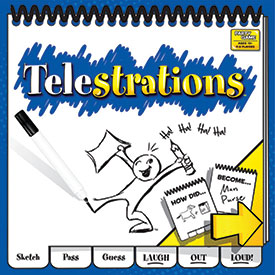 Telestrations
Telestrations
A game for a party
Pictionary is an old stand-by among people who like party games; Telestrations takes this to the next level by combining it with that old classic game of Telephone. In Telestrations, each player gets a card with a word or phrase on it and then has to draw that word. When time is up, every player passes their picture to their neighbor. That player then looks at the pictures and writes his or her best guess as to what that picture is. Players then pass those words or phrases to their neighbors, who draw a picture based on that word or phrase.
This alteration of words and pictures happen until each player gets their original pad back. At that point, players go through and everyone gets a good laugh as to how the phrase or word evolved over time through misunderstandings.
You could probably play this game with a Pictionary set and some paper, but Telestrations is fairly inexpensive, comes with neat pads and dry erase markers that make the process much easier. It’s a lot of fun and leads to a lot of laughter. I do have to say that the scoring rules provided in the game don’t work very well, but if you’re primarily concerned with games where winning or losing is the point, this probably isn’t for you. The game can handle up to eight players and, as with all party games, the more players you have, the more fun it is.
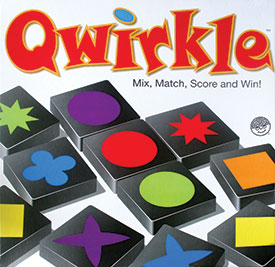 Qwirkle
Qwirkle
A game for camping
Camping is a great time for game playing. There’s no television or other distractions of modern life, so it’s a good time for boardgaming. An ideal camping game shouldn’t have lots of little bits or paper that can get dirty, wet, or lost. In this way, Qwirkle is perfect. It comes with a whole bag of big chunky wooden tiles with colored shapes on them. Qwirkle is an abstract game, played with wooden tiles that have colored shapes on them. There are six colors and six shapes. In a turn, players can play a set of tiles all in one color, as long as all the shapes are different) or a set of tiles of one shape, as long as they’re all different colors.
This abstract strategy game feels a lot like Scrabble when you play it. If you don’t camp, it’s still an excellent and accessible game for all ages. In 2011, Qwirkle won the most prestigious game award in the world, Germany’s Spiele des Jahres.
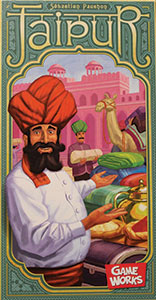 Jaipur
Jaipur
A two-player game
There are lots of times when there are only two of you and you want to play a game. In my house, Jaipur has become the go-to game in that situation. Jaipur is a game of trading and collecting sets of goods represented by cards. In a turn, a player can take one card from the market, trade multiple cards for multiple cards in the market, or sell goods.
The clever thing in Jaipur is that the first good of a type sold is worth the most; as the market gets saturated with a particular good, its value decreases. Players can earn bonuses if they trade in larger sets of goods, but trying to build up a large set of goods in your hand might allow the other player to sell off a few goods first for higher prices. To succeed, you have to play close attention to what your opponent is doing. This one is probably the hardest to find of the games on this list; you may have to try an online game store if you want to locate a copy.
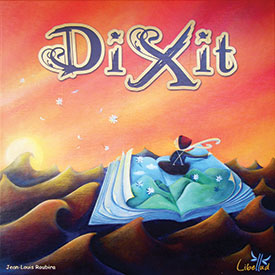 Dixit
Dixit
A game when you’re feeling creative
Most games are decidedly left brain activities, relying on logic and reasoning. Dixit is a right brain kind of game, rewarding creativity over strategic play. The game consists of a deck of beautifully illustrated cards, with no words on them. Every player has a hand of cards.
In each turn, one player is the storyteller and chooses a card to play. That player comes up with a word, a phrase or a sentence to describe the card. The other players all chose a card from their hands that they think best exemplifies that phrase. All of the cards are then mixed and the players who are not the storyteller vote on the one they think is the storyteller’s card. What makes the game work is the scoring system. In the case that all players choose the storyteller’s card or none of the players choose it, the storyteller gets no points and every other player gets two points. In all other situations, the storyteller and any player who correctly identified the storyteller’s card gets three points. Furthermore, any of the other players who attract votes get a point. This system encourages the storyteller to choose a phrase that is neither too obvious nor too obscure, a tricky balance to maintain. Dixit is a simple game to play, but I find it taxes it my brain in a way no other game in my collection does.
Oh, and in 2010 it also won the prestigious Spiele des Jahres (Game of the Year).
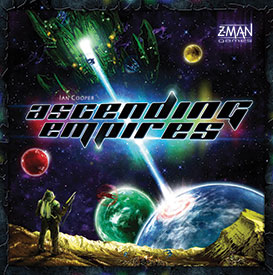 Ascending Empires
Ascending Empires
A game when you want to get physical
In many ways, Ascending Empires is a pretty classic space empire game. Players start with one planet and expand to nearby planets, colonizing them, mining resources and establishing science stations. Planets come in different colors and in order to advance in technology, it’s necessary to establish a presence on several different color planets. This inevitably leads to conflict with other players and space battles.
Here’s what’s different about Ascending Empires: in order to move the wooden disks representing your ships around, you have to flick them with your finger. This leads to a lot of laughter and fun as carefully planned flights go astray. The game manages to strike a near perfect balance between physical dexterity and strategy. Flicking your ships across the board is a blast, but clever strategic play is ultimately going to decide who wins, much to the relief of those of us who are not particularly coordinated. This is another one that may not be easy to find; on-line game stores are probably your best bet.
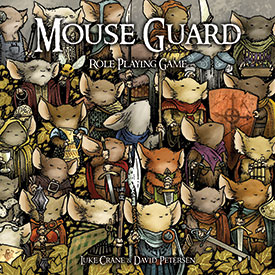 Mouse Guard Role Playing Game
Mouse Guard Role Playing Game
A game to indulge your inner storyteller
Role playing games are games where players collectively tell a story. One player runs the game; the others play characters in the story. When done well, it’s an incredibly fun and immersive experience. Most of these games, however, are set in fantasy settings with warriors, wizards and dragons. If the idea of role playing is appealing, but these typical games settings are not, Mouse Guard may be for you.
Based on David Peterson’s graphic novels of the same name, players take on the role of mice dedicated to protecting their civilization from the perils of the outside world. When you think about how small mice are, there’s plenty of material for compelling adventures in seemingly mundane things. In one mission I played with my children, the mice had to save a mouse settlement from flooding after beavers built a dam near the town.
Although an excellent game to play with younger players, it also works well with adults, with plenty of opportunity for interpersonal drama and darker conflict. All you need to play are some dice and the 320-page rulebook, which is readily available from online bookstores. Alternatively, you can opt for the beautiful boxed set, with additional missions and play aids. The game materials are well-written and gorgeous, with hundreds of Peterson’s illustrations. It takes a bit of reading to get a handle on the rules, but it is a more streamlined and easy-to-grasp system than most role-playing games. The book provides lots of guidance in how to structure and run missions, and rewards good role playing, not clever dice play.







